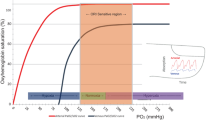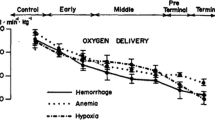Summary
The role of monitoring during endoscopy is not clearly defined. We have prospectively investigated continuous arterial oxygen saturation (S aO2) monitoring in 326 patients undergoing upper endoscopy (EGD) and 90 undergoing colonoscopy. Automated blood pressure recording was evaluated in 278 of these patients.S aO2 desaturation (<90%) occurred in 17.8% of patients undergoing EGD and 12.9% undergoing colonoscopy. Systolic blood pressure abnormalities (>200 or <90 mmHg) occurred in 19.8% of EGD patients and 19.6% of colonoscopy patients. Treatment based on these abnormalities was required in 4.3% of patients during EGD and 8.8% during colonoscopy. A history of pulmonary or cardiac disease predicted increased risk during colonoscopy, while cardiac disease and age 60 years or above predicted desaturation during EGD. Pulse oximetry and automated blood pressure monitoring was especially valuable during endoscopy in the elderly and patients with cardiac or pulmonary disease. It may be used as a guide to therapeutic intervention and to avert major cardiopulmonary complications.
Similar content being viewed by others
References
Bell GD, Bown S, Morden A, et al (1987) Prevention of hypoxemia during upper gastrointestinal endoscopy by means of oxygen via nasal cannulae. Lancet I: 1022–1024
Bilotta J, Floyd JL, Waynes JD (1989) Incidence, predictability and clinical insignificance of arterial desaturation during ambulatory colonoscopy (abstract). Gastrointest Endosc 35: 177–178
Bough EW, Meyers S (1978) Cardiovascular responses to upper gastrointestinal endoscopy. Am J Gastroenterol 69: 655–660
Davis RE, Graham DY (1979) Endoscopic complications — the Texas experience. Gastrointest Endosc 25: 146–149
Davison ET, Levine M, Meyerowitz R (1985) Ventricular fibrillation during colonoscopy: case report and review of the literature. Am J Gastroenterol 80: 690–693
Gilbert DA, Shaneyfelt SL, Mahler AK, et al (1983) The national ASGE colonoscopy survey-preliminary analysis of complications of colonoscopy (abstract). Gastrointest Endosc 29: 191
Hayward SR, Wilson RF, Sugawa C (1989) Changes in cardiopulmonary function during gastrointestinal endoscopy (abstract). Crit Care Med 17: S138
Hayward SR, Sugawa C, Wilson RF (1989) Changes in oxygenation and pulse rate during endoscopy. Am Surg 55: 198–202
Lieberman DA, Wuerker CK, Katon RM (1985) Cardiopulmonary risk of esophagogastroduodenoscopy. Gastroenterology 88: 468–472
Macrae FA, Tank G, Williams CB (1983) Toward safer colonoscopy: a report on the complications of 5000 diagnostic or therapeutic colonoscopies. Gut 24: 376–383
Mandelstam P, Sugawa C, Silvis SE, et al (1976) Complications associated with esophageal gastroduodenoscopy and with esophageal dilation. Gastrointest Endosc 234: 16–19
Pecora AA, Chiesa JC, Alloy AM, et al (1984) The effect of upper gastrointestinal endoscopy on arterial O2 tension in smokers and nonsmokers with and without premedication. Gastrointest Endosc 30: 284–288
Reiertsen O, Skjoto J, Jacobsen CD, et al (1987) Complications of fiberoptic gastrointestinal endoscopy — five years experience in a central hospital. Endoscopy 19: 1–6
Rimmer KP, Graham K, Whitelaw WA, et al (1989) Mechanisms of hypoxemia during panendoscopy. J Clin Gastroenterol 11: 17–22
Rostykus PS, McDonald GB, Albert RK (1980) Upper intestinal endoscopy induces hypoxemia in patients with obstructive pulmonary disease. Gastroenterology 78: 488–491
Rozen P, Fireman Z, Gilat T (1982) The causes of hypoxemia in elderly patients during endoscopy. Gastrointest Endosc 28: 243–246
Silvis SE, Nebel O, Rogers G, et al (1976) Endoscopic complications — results of the 1974 American Society for Gastrointestinal Endoscopy Survey. JAMA 235: 928
Smith LE (1976) Fiberoptic colonoscopy: complications of colonoscopy and polypectomy. Dis Colon Rectum 19: 407–412
Author information
Authors and Affiliations
Rights and permissions
About this article
Cite this article
Steffes, C.P., Sugawa, C., Wilson, R.F. et al. Oxygen saturation monitoring during endoscopy. Surg Endosc 4, 175–178 (1990). https://doi.org/10.1007/BF02336600
Issue Date:
DOI: https://doi.org/10.1007/BF02336600




